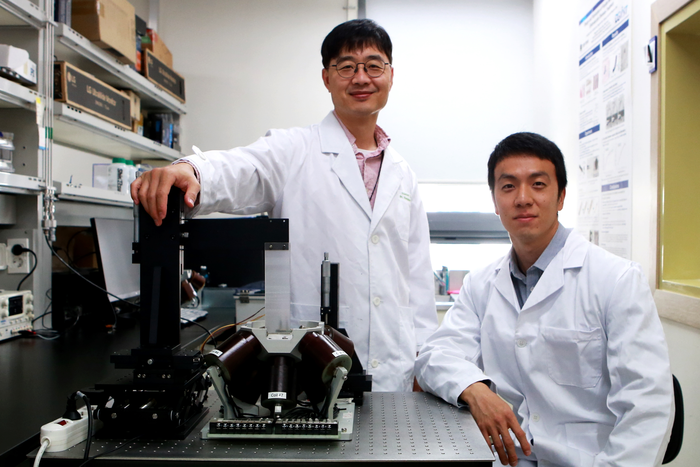
Prof. Choi, Hongsoo (left) and Dr Jeon, Seongwoong (right) at Robotics Engineering, DGIST. Image Credit: Daegu Gyeongbuk Institute of Science and Technology.
The researchers also developed a method for minimally invasive delivery of therapeutic agents into the brain through the intranasal pathway. The researchers could also transplant the designed stem cell-based microrobot into brain tissue via the intranasal pathway that bypasses the blood-brain barrier.
The new approach is excellent when it comes to safety and is more efficient than the traditional surgical method. It is anticipated to bring new prospects for treating several intractable neurological diseases like brain tumors, Parkinson’s disease, and Alzheimer’s disease in the future.
The drawback of stem cell therapy is that it is hard to deliver the right amount of stem cells to a precisely targeted location deep within the body where the treatment comes with greater risk. One more drawback is that both the safety and efficacy of the treatment are low because of the loss of a huge amount of the therapeutic agent at the time of delivery, while the treatment cost is high.
Specifically, while delivering stem cells into the brain via blood, there may be a drop in the efficiency of cell delivery as a result of the so-called “blood-brain barrier”—a specific and special component of the cerebrovascular network.
The collaborative research group at DGIST and Seoul St. Mary’s Hospital of the Catholic University solved these problems by developing the microrobot that could be controlled freely and dependably inside the human body by applying an external magnetic field.
As part of the study, they designed the microrobot by internalizing iron oxide nanoparticles with superparamagnetism and high biocompatibility into stem cells extracted from human nasal turbinate.
The newly designed microrobot has the ability to execute translational motion and rolling motion by a magnetic field gradient and an externally-controlled rotating magnetic field, respectively. This allows efficient transport in several physiological environments in vivo. Thus, when an external magnetic field is applied, the microrobot can be manipulated remotely inside the microfluidic channel. This enables rapid and precise delivery to the target point.
Furthermore, the researchers confirmed that the new microrobot was dependably transplanted to the brain tissue. Specifically, the researchers injected the developed microrobot through the intranasal passage that bypassed the blood-brain barrier of mice, for the first time in the world. They also moved the microrobot inside the brain tissue with the help of an external magnetic field for accurate delivery to the cerebral cortex. Thus, they achieved a successful transplant.
This research overcomes the limitations in the delivery of a therapeutic agent into brain tissues owing to the blood-brain barrier. It opens new possibilities for the treatment of various intractable neurological diseases, such as Alzheimer’s disease, Parkinson’s disease, and brain tumors, by enabling accurate and safe targeted delivery of stem cells through the movement of a magnetically powered hNTSC-based microrobot via the intranasal pathway.
Hongsoo Choi, Professor, Daegu Gyeongbuk Institute of Science and Technology
This work was financially supported by the National Research Foundation of Korea, the Ministry of Science and ICT and the Ministry of Health and Welfare.
Journal Reference:
Jeon, S., et al. (2021) A Magnetically Powered Stem Cell-Based Microrobot for Minimally Invasive Stem Cell Delivery via the Intranasal Pathway in a Mouse Brain. Advanced Healthcare Materials. doi.org/10.1002/adhm.202170089.